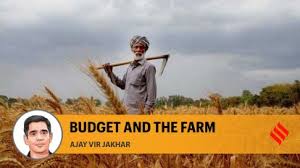07 Jan 2025 Indian Express Editorial
What to Read in Indian Express Editorial( Topic and Syllabus wise)
Editorial 1 : Budget and the Farm
Context: Uniform taxation can turn the agricultural sector around.
Key Challenges in Indian Agriculture
- Persistent Issues in Government Programmes
- Lack of Beneficiary-Centric Audits: Despite the suggestion to audit agricultural programmes by beneficiaries, bureaucratic resistance prevents its implementation.
- Repetition of Ineffective Suggestions: Annual budget consultations with farmer representatives often include repetitive or irrelevant proposals.
- Agricultural Research System Deficiencies
- Failure to Close Yield Gaps: The Indian agricultural research system has not succeeded in significantly improving crop productivity.
- Spread of Scarce Resources: Resources are distributed thinly across all crop types, limiting the potential for transformative breakthroughs.
- Dependence on Imports: India remains excessively reliant on imports for nutritionally critical crops like pulses and oilseeds.
- Stagnant Growth
- Negative Growth in Value of Output: Nearly 45% of Indian farmers, who grow only field crops, have seen zero or negative growth in output value over a decade.
- Marketing Issues for Perishable Crops: Marketing perishable horticulture produce remains a persistent challenge, with price fluctuations adding to farmers' woes.
- Complexity in Reforms
- Resistance to Market Deregulation: Attempts to reform agricultural markets have faced pushback due to the complexities of federal governance.
- State Revenue Dependency: States rely on market fees from horticultural produce, making them reluctant to reduce charges.
Way Forward: Proposed Solutions
- Invest in Research
- Targeted Funding for Key Crops: Allocate ₹1,000 crore annually for eight years to gram/chickpea, soybean (kharif), and mustard (rabi) to achieve research breakthroughs.
- Strategic Thinking in Land Use: Align agricultural strategies to prepare for climate change and achieve national development goals.
- Reform Agri-Markets
- Uniform Taxation: Introduce uniform taxation in agricultural markets (akin to GST) to improve governance, reduce food inflation, and stabilize prices.
- Compensate States for Revenue Losses: Through the 16th Finance Commission, the Centre can compensate states for reducing horticultural market fees to 0.1% for five years.
- Data-Driven Policy: Implement nominal fees for real-time data collection and mining to improve market transparency.
- Promote Competition: Regulated competition in agricultural markets could benefit both farmers and consumers, fostering innovation and efficiency.
Budgetary and Policy Implications
- Inadequate Strategic Thinking: Budget allocations for agriculture often lack a cohesive strategy to address competing land-use objectives or prepare for climate change.
- Potential Gains from Market Reforms: Streamlining fees and improving governance can lead to enhanced farmer incomes and reduced-price volatility.
Conclusion
The lack of strategic thinking in agriculture has left the nation unprepared for climate change or making Bharat viksit. By prioritizing targeted investments, implementing market reforms, and fostering entrepreneurship, India can address its agricultural challenges and secure a sustainable future for its farmers.
Editorial 2 : A Stronger STEM
Context: Quota for women at IIT and proof that inclusion works.
Introduction: The increasing representation of women in the Indian Institutes of Technology (IITs) marks a pivotal moment in the journey toward greater inclusivity and gender equity in India’s premier institutions of higher education.
Women’s Representation in IITs
- Supernumerary Quota
- Implementation: Introduced in 2018, a 20% supernumerary quota for women in undergraduate engineering programmes created extra seats instead of reserving them within the existing pool.
- Increased Enrolment
- At IIT-Kanpur, the number of women rose from 908 in 2017 to 2,124 in 2024.
- IIT-Roorkee saw a 76.36 per cent jump between 2019-20 and 2024.
- IITs in Chennai, Mumbai, Guwahati and Kharagpur, too, saw commensurate jumps in enrolment.
- Positive Outcomes
- Reshaping Male-Dominated Spaces
- Increased representation challenges the narrative that STEM is a field for men.
- Promotes an environment where women’s ideas and innovations are integral in shaping the country's technological and intellectual future.
- Infrastructure Upgrades
- More hostels, washrooms, and recreational facilities tailored for women.
- Special open-door policies for female aspirants and their parents to familiarize themselves with campus life.
- Reshaping Male-Dominated Spaces
Challenges and Way Forward
- Gender Disparity in Engineering Education: According to the All-India Survey on Higher Education (AISHE) for 2021-22, women still comprise only 11.3 lakh, while 27.6 lakh are men in the undergraduate programmes, it is crucial to bridge the gap.
- Transition from Classroom to Workplace
- Focus needed to ensure women’s progress does not stall post-education.
- Barriers in economic opportunities must be addressed to harness women’s potential fully.
- Creating a Supportive Environment in IITs
- Tackling Everyday Sexism: Safeguards against biases must continue to evolve to ensure women can thrive without discrimination.
- Equipping Women for Success: Resources, mentorship, and an inclusive culture are essential to help women realize their potential.
Conclusion
As with the field of medicine, where for every 100 men there were 100 women enrolled in medical colleges in India in 2020-21, the increased presence of women in IITs can only be counted as a job well begun. With more women poised to enter the workforce, it is time to ensure that gender-neutral policies, mentorship, and a culture of inclusivity allow them to realise their potential more fully.


